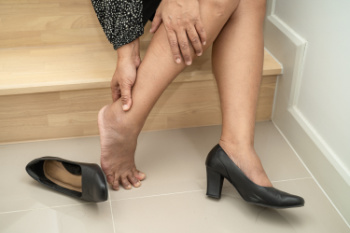Connect With Us
Blog
 Plantar heel pain, often referred to as plantar fasciitis, can cause discomfort and interfere with daily activities. It typically occurs when the band of tissue that supports the arch of the foot, called the plantar fascia, becomes irritated or inflamed. This condition often brings sharp pain in the heel, especially when taking the first steps in the morning or after prolonged periods of rest. Plantar heel pain can be triggered by various factors, including overuse, improper footwear, obesity, or certain foot structures. A podiatrist, or foot doctor, may recommend treatments such as stretching exercises, orthotic inserts, or in severe cases, corticosteroid injections and possibly surgery. With proper care and treatment, most people can find relief from plantar heel pain and get back to enjoying their daily activities without discomfort. If you are suffering from heel pain, it is suggested that you make an appointment with a podiatrist.
Plantar heel pain, often referred to as plantar fasciitis, can cause discomfort and interfere with daily activities. It typically occurs when the band of tissue that supports the arch of the foot, called the plantar fascia, becomes irritated or inflamed. This condition often brings sharp pain in the heel, especially when taking the first steps in the morning or after prolonged periods of rest. Plantar heel pain can be triggered by various factors, including overuse, improper footwear, obesity, or certain foot structures. A podiatrist, or foot doctor, may recommend treatments such as stretching exercises, orthotic inserts, or in severe cases, corticosteroid injections and possibly surgery. With proper care and treatment, most people can find relief from plantar heel pain and get back to enjoying their daily activities without discomfort. If you are suffering from heel pain, it is suggested that you make an appointment with a podiatrist.
Many people suffer from bouts of heel pain. For more information, contact Katie Besselman, DPM of Advanced Podiatry. Our doctor can provide the care you need to keep you pain-free and on your feet.
Causes of Heel Pain
Heel pain is often associated with plantar fasciitis. The plantar fascia is a band of tissues that extends along the bottom of the foot. A rip or tear in this ligament can cause inflammation of the tissue.
Achilles tendonitis is another cause of heel pain. Inflammation of the Achilles tendon will cause pain from fractures and muscle tearing. Lack of flexibility is also another symptom.
Heel spurs are another cause of pain. When the tissues of the plantar fascia undergo a great deal of stress, it can lead to ligament separation from the heel bone, causing heel spurs.
Why Might Heel Pain Occur?
- Wearing ill-fitting shoes
- Wearing non-supportive shoes
- Weight change
- Excessive running
Treatments
Heel pain should be treated as soon as possible for immediate results. Keeping your feet in a stress-free environment will help. If you suffer from Achilles tendonitis or plantar fasciitis, applying ice will reduce the swelling. Stretching before an exercise like running will help the muscles. Using all these tips will help make heel pain a condition of the past.
If you have any questions please contact our office located in Saint Peters, MO . We offer the newest diagnostic and treatment technologies for all your foot and ankle needs.

Stress fractures are common injuries to the bones of the legs and feet, resulting from repetitive stress rather than sudden injury. These hairline cracks in the bone affect athletes, including runners, basketball players, or dancers. Pain from stress fractures is particularly felt during weight-bearing activities and direct pressure on the bone. They may be difficult to diagnose as the pain often subsides when activity stops. Because they do not always show up on an X-ray, further diagnostic tests, like CT or MRI scans may be needed. Left untreated, stress fractures in the feet or ankles can worsen, leading to more severe complications. Seeking timely medical attention from a podiatrist is essential for proper diagnosis and treatment tailored to individual needs. This facilitates pain relief, promotes healing, and prevents further damage. If you are experiencing symptoms suggestive of a stress fracture, it is suggested that you schedule an appointment with a podiatrist.
Activities where too much pressure is put on the feet can cause stress fractures. To learn more, contact Katie Besselman, DPM from Advanced Podiatry. Our doctor can provide the care you need to keep your pain free and on your feet.
Dealing with Stress Fractures of the Foot and Ankle
Stress fractures occur in the foot and ankle when muscles in these areas weaken from too much or too little use. The feet and ankles then lose support when walking or running from the impact of the ground. Since there is no protection, the bones receive the full impact of each step. Stress on the feet can cause cracks to form in the bones, thus creating stress fractures.
What Are Stress Fractures?
Stress fractures occur frequently in individuals whose daily activities cause great impact on the feet and ankles. Stress factors are most common among:
- Runners
- People affected with Osteoporosis
- Tennis or basketball players
- Gymnasts
- High impact workouts
Symptoms
Pain from the fractures occur in the area of the fractures and can be constant or intermittent. It will often cause sharp or dull pain with swelling and tenderness. Engaging in any kind of activity which involves high impact will aggravate pain.
If you have any questions please feel free to contact our office located in Saint Peters, MO . We offer the newest diagnostic and treatment technologies for all your foot and ankle needs.
 Wearing improper footwear, particularly shoes that lack adequate support or fit poorly, can significantly contribute to hind-foot pain. High heels and narrow-toed shoes, while fashionable, can place excessive stress on the structures of the hind-foot. The heel and ankle are two particularly susceptible areas for pain. Wearing these kinds of shoes can also lead to conditions like plantar fasciitis, Achilles tendonitis, and bursitis. These styles force the foot into an unnatural position, disrupting alignment and increasing pressure on the back of the foot. Stress on the foot over time not only leads to pain and discomfort but also can significantly affect mobility and quality of life. It is important to choose shoes with proper support, cushioning, and a fit that accommodates the natural shape of the foot to prevent hind-foot pain. Podiatrists often stress the importance of wearing shoes that complement one's lifestyle as well as provide the foundation for healthy foot posture and function. If you are experiencing pain in the back of the foot, it is suggested that you visit a podiatrist for a full diagnosis and proper shoe recommendations to support your recovery.
Wearing improper footwear, particularly shoes that lack adequate support or fit poorly, can significantly contribute to hind-foot pain. High heels and narrow-toed shoes, while fashionable, can place excessive stress on the structures of the hind-foot. The heel and ankle are two particularly susceptible areas for pain. Wearing these kinds of shoes can also lead to conditions like plantar fasciitis, Achilles tendonitis, and bursitis. These styles force the foot into an unnatural position, disrupting alignment and increasing pressure on the back of the foot. Stress on the foot over time not only leads to pain and discomfort but also can significantly affect mobility and quality of life. It is important to choose shoes with proper support, cushioning, and a fit that accommodates the natural shape of the foot to prevent hind-foot pain. Podiatrists often stress the importance of wearing shoes that complement one's lifestyle as well as provide the foundation for healthy foot posture and function. If you are experiencing pain in the back of the foot, it is suggested that you visit a podiatrist for a full diagnosis and proper shoe recommendations to support your recovery.
Foot Pain
Foot pain can be extremely painful and debilitating. If you have a foot pain, consult with Katie Besselman, DPM from Advanced Podiatry. Our doctor will assess your condition and provide you with quality foot and ankle treatment.
Causes
Foot pain is a very broad condition that could be caused by one or more ailments. The most common include:
- Bunions
- Hammertoes
- Plantar Fasciitis
- Bone Spurs
- Corns
- Tarsal Tunnel Syndrome
- Ingrown Toenails
- Arthritis (such as Gout, Rheumatoid, and Osteoarthritis)
- Flat Feet
- Injury (from stress fractures, broken toe, foot, ankle, Achilles tendon ruptures, and sprains)
- And more
Diagnosis
To figure out the cause of foot pain, podiatrists utilize several different methods. This can range from simple visual inspections and sensation tests to X-rays and MRI scans. Prior medical history, family medical history, and any recent physical traumatic events will all be taken into consideration for a proper diagnosis.
Treatment
Treatment depends upon the cause of the foot pain. Whether it is resting, staying off the foot, or having surgery; podiatrists have a number of treatment options available for foot pain.
If you have any questions, please feel free to contact our office located in Saint Peters, MO . We offer the newest diagnostic and treatment technologies for all your foot care needs.
 Swollen and painful ankles can be caused by conditions that range from minor injuries to systemic health conditions. Ankle sprains, which occur when the ligaments that support the ankle are stretched or torn, are among the most common reasons for these symptoms. Sprains typically result from twisting or rolling the ankle awkwardly. Another prevalent cause of swelling is arthritis, which leads to inflammation of the joints, including those in the ankle. Conditions such as gout, where crystals accumulate in the joints, can also target the ankles and lead to intense pain and inflammation. Furthermore, venous insufficiency, a condition in which the veins struggle to send blood from the legs back to the heart, can cause swelling because of excess fluid. Systemic diseases like heart failure, kidney disease, and liver problems can result in ankle swelling due to fluid retention. Identifying the root cause of swollen and painful ankles is important for determining the appropriate treatment strategy, and this is something a foot doctor, or podiatrist, can do. If you have painful or swollen ankles, it is suggested that you promptly schedule an appointment with a podiatrist for diagnosis and treatment.
Swollen and painful ankles can be caused by conditions that range from minor injuries to systemic health conditions. Ankle sprains, which occur when the ligaments that support the ankle are stretched or torn, are among the most common reasons for these symptoms. Sprains typically result from twisting or rolling the ankle awkwardly. Another prevalent cause of swelling is arthritis, which leads to inflammation of the joints, including those in the ankle. Conditions such as gout, where crystals accumulate in the joints, can also target the ankles and lead to intense pain and inflammation. Furthermore, venous insufficiency, a condition in which the veins struggle to send blood from the legs back to the heart, can cause swelling because of excess fluid. Systemic diseases like heart failure, kidney disease, and liver problems can result in ankle swelling due to fluid retention. Identifying the root cause of swollen and painful ankles is important for determining the appropriate treatment strategy, and this is something a foot doctor, or podiatrist, can do. If you have painful or swollen ankles, it is suggested that you promptly schedule an appointment with a podiatrist for diagnosis and treatment.
Ankle pain can be caused by a number of problems and may be potentially serious. If you have ankle pain, consult with Katie Besselman, DPM from Advanced Podiatry. Our doctor will assess your condition and provide you with quality foot and ankle treatment.
Ankle pain is any condition that causes pain in the ankle. Due to the fact that the ankle consists of tendons, muscles, bones, and ligaments, ankle pain can come from a number of different conditions.
Causes
The most common causes of ankle pain include:
- Types of arthritis (rheumatoid, osteoarthritis, and gout)
- Ankle sprains
- Broken ankles
- Achilles tendinitis
- Achilles tendon rupture
- Stress fractures
- Bursitis
- Tarsal tunnel syndrome
- Plantar fasciitis
Symptoms
Symptoms of ankle injury vary based upon the condition. Pain may include general pain and discomfort, swelling, aching, redness, bruising, burning or stabbing sensations, and/or loss of sensation.
Diagnosis
Due to the wide variety of potential causes of ankle pain, podiatrists will utilize a number of different methods to properly diagnose ankle pain. This can include asking for personal and family medical histories and of any recent injuries. Further diagnosis may include sensation tests, a physical examination, and potentially x-rays or other imaging tests.
Treatment
Just as the range of causes varies widely, so do treatments. Some more common treatments are rest, ice packs, keeping pressure off the foot, orthotics and braces, medication for inflammation and pain, and surgery.
If you have any questions, please feel free to contact our office located in Saint Peters, MO . We offer the newest diagnostic and treatment technologies for all your foot care needs.



